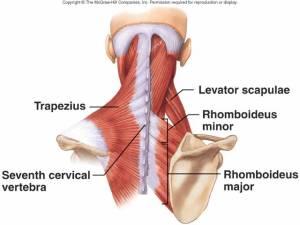 The shoulder blade or scapula serves a crucial role in shoulder motions and can be the limiting factor in many athletes or individuals with shoulder pain. On a number of occasions, I’ve had patients come in after attempting physical therapy with no relief of symptoms. When asked about their exercise routine, many times they report they focused on strengthening the rotator cuff muscles and no emphasis on the scapular muscles. The scapula is the “CORE” of the shoulder joint meaning that it provides a stable or unstable base from which the shoulder moves. The scapula moves up and down, out and in and rotates around the rib cage allowing the shoulder joint or glenohumeral joint to function. If the posture of the shoulder blade is rotated, winged or excessively protracted, the shoulder is placed at a disadvantage to move and can cause unwanted impingement, pain and discomfort.
The shoulder blade or scapula serves a crucial role in shoulder motions and can be the limiting factor in many athletes or individuals with shoulder pain. On a number of occasions, I’ve had patients come in after attempting physical therapy with no relief of symptoms. When asked about their exercise routine, many times they report they focused on strengthening the rotator cuff muscles and no emphasis on the scapular muscles. The scapula is the “CORE” of the shoulder joint meaning that it provides a stable or unstable base from which the shoulder moves. The scapula moves up and down, out and in and rotates around the rib cage allowing the shoulder joint or glenohumeral joint to function. If the posture of the shoulder blade is rotated, winged or excessively protracted, the shoulder is placed at a disadvantage to move and can cause unwanted impingement, pain and discomfort.
“Mom always knows best” I learned at an early age how important posture was especially when my mother would tap me on the back between my shoulder blades, telling me “sit up straight”. Little did she know how smart she was. She was giving a tactile cue to my rhomboids to wake up and help me sit in a better alignment.
 Many muscles stabilize the scapula however the main stabilizers are the levator scapulae, rhomboids, serratus anterior and the trapezius. The four rotator cuff muscles all attach to the scapula so depending on the scapular position, all of these muscles can be placed in positions that can excessively stretch or shorten these muscles causing pain or compensation. The most common weak links/muscles in the scapular-humeral chain are the lower stabilizers including the serratus anterior, rhomboids, middle and lower trapezii.
Many muscles stabilize the scapula however the main stabilizers are the levator scapulae, rhomboids, serratus anterior and the trapezius. The four rotator cuff muscles all attach to the scapula so depending on the scapular position, all of these muscles can be placed in positions that can excessively stretch or shorten these muscles causing pain or compensation. The most common weak links/muscles in the scapular-humeral chain are the lower stabilizers including the serratus anterior, rhomboids, middle and lower trapezii.
Specificity of Training
Although many of the main stabilizers of the shoulder contract during many upper body movements such as pushes and pulls, their main job is to stabilize the shoulder joint. Our first goal in neuromuscular retraining is to get the muscles to wake up. In the following video, a sequence known as SHARCing or Short-arcing is performed to increase neurological input to the muscle and wake it up. Each exercise is performed for 6 repetitions as fast as possible. Perform 2-3 sets before any shoulder or scapular exercise.
Once activated, the scapular muscles can be trained in quadriped position in the following video.
Progressions of the quadriped exercises can be found at www.discovermovement.com. I’d love to hear your feedback and questions. Please leave a comment or email me at bodydynamixpt@gmail.com
Should your patients focus on longer holds with the scapular exercises versus SHARCing them, since postural muscles are endurance muscles?
Joe thanks for writing in. Your correct that the scapular muscles are postural muscles and need to build endurance however we need to first “wake up” the muscles with the SHARCING exercises and then progress to postural holds like isometric rows and standing snow angels where you hold a stability ball between the back of your hand and the wall using the scapular muscles to hold it up. We’ll try to get pictures up of these exercises soon. If someone does static holds prior to Sharcing, they may continue to use poor muscle motor patterns and compensate to perform the exercises. Thanks again.